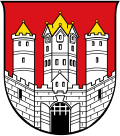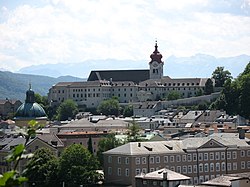Salzburg
Salzburg (German pronunciation: [ˈsaltsbʊɐ̯k]; German: [ˈzaltsbʊɐ̯k] (![]() listen);[note 1] literally "Salt Fortress"; Austro-Bavarian: Soizbuag) is the capital and also a district of the Austrian state of Salzburg or Salzburgerland. The population is about 150,000 and is the 4th largest city of Austria.
listen);[note 1] literally "Salt Fortress"; Austro-Bavarian: Soizbuag) is the capital and also a district of the Austrian state of Salzburg or Salzburgerland. The population is about 150,000 and is the 4th largest city of Austria.
|
From top, left to right: view of Hohensalzburg Fortress, University of Salzburg in front of the Salzach, with Nonnberg Abbey in the background, Salzburg Cathedral, Roittner-Durchhaus, Getreidegasse | |
| Coordinates: 47°48′0″N 13°02′0″E / 47.80000°N 13.03333°ECoordinates: 47°48′0″N 13°02′0″E / 47.80000°N 13.03333°E | |
| Country | |
| State | Salzburg |
| District | Statutory city |
| Government | |
| • Mayor | Harald Preuner (ÖVP) |
| Elevation | 424 m (1,391 ft) |
| Population (1 October 2020)[1] | |
| • Total | 157,245 |
| Time zone | UTC+1 (CET) |
| • Summer (DST) | UTC+2 (CEST) |
| Postal code | 5020 |
| Vehicle registration | S |
| Website | www |
| UNESCO World Heritage Site | |
|---|---|
 | |
| Criteria | Cultural: ii, iv, vi |
| Reference | 784 |
| Inscription | 1996 (20th Session) |
| Area | 236 ha |
| Buffer zone | 467 ha |
Its most famous citizen was Wolfgang Amadeus Mozart. Another famous inhabitant of Salzburg was the physicist Christian Doppler who found the Doppler effect which was named after him.
The Salzach river crosses the city. The old town was adopted by the UNESCO as World Heritage Site in 1996. Known is Salzburg also for being one of the settings for the movie "The Sound of Music" which based on the musical by Richard Rodgers and Oscar Hammerstein.
History
People lived in Salzburg since the New Stone Age till present. The oldest finding in the city area is dated around 4500 B.C. From 15 B.C. onwards after the Roman occupation the city was called Iuvavum. The roman city was in today's old town around the Waagplatz. The city became an important place from the east to the province of Germania. The Romans left on the beginning of the barbarian migration around 500. Up to 696 only little can be said about the history. In 696 the city was given to bishop Rupert by Duke Theodo II. of Bavaria.
Rupert was ordered by the Duke to bring Christianity to the east and southeast of his country. Rupert founded the monastery St. Peter and for women the monastery Nonnberg. 739 Salzburg became the seat of a bishop and 774 the first cathedral was built. 998 Salzburg became archbishopric ruling the whole Bavarian area.
In the Middle Ages Salzburg became wealthy by the trade with salt from the nearby Dürnberg in Hallein. Till the 14th century Salzburg became independent from Bavaria and was a state within the Holy Roman Empire. The citizens of Salzburg were under the command of the archbishop unlike other cities in the empire. In the baroque era the look of today's city was shaped. The cathedral was rebuilt in the baroque style. Most of the architects came from Italy. 1622 a university was founded. Due to the fact that it was a catholic state Protestants had a severe standing in Salzburg. Yet 1731 Protestants, who came not back to the catholic belief had do leave Salzburg within eight days.
In the early 19th century Napoleon Bonaparte promoted the Duchy of Salzburg, than later was a part of the Kingdom of Bavaria. Then, Salzburg was annexed by Austria, returned to Bavarian and divided between Bavaria and Austria. 1918 Salzburg became a federal state of the new Republic of Austria.
In 1938, Germany annexed Austria and Salzburg was a part of Germany. In 1945, when Austria was independent from Germany. It became a federal state again.
Urban districts
Urban districts (Stadtteile):
Mayors of the city since it became part of Austria
1816 - 1875
- Magistrat without mayor 1816 bis 1818
- Anton von Heffter 1818 - 1831
- Alois Lergetporer 1831 - 1847
- Mathias Gschnitzer 1847 - 1850
- Franz Xaver Späth 1850 - 1853
- Alois Spängler 1854 - 1861
- Heinrich Ritter von Mertens 1861 - 1872
- Ignaz Harrer 1872 - 1875
1875 - 1919
1919 bis 1945
- Josef Preis 1919 - 1927
- Max Ott 1927 - 1935
- Richard Hildmann 1935 - 1938
- Anton Giger, 1938 - 1945 - „Oberbürgermeister der Gauhauptstadt Salzburg“ during Nazi occupation
1945 bis 1999
Mayor elected directly by the people from 1999 onwards
- Heinz Schaden since 1999
Monuments
Salzburg is a World Heritage. There are some places of interest like:
Other places of interest
- Mirabell Palace with Mirabell Garden
- Augustiner Bräustübl Mülln (beer garden of the Augustiner brewery)
- Hellbrunn palace
Famous citizens
- Wolfgang Amadeus Mozart, composer
- Gerhard Amanshauser, writer
- Gerd Bacher, journalist
- Christian Doppler, mathematician and physicist
- Herbert von Karajan, conductor
- Angelika Kirchschlager, singer
- Genia Kühmeier, singer
- Hans Makart, painter
- Georg Trakl, lyric poet
- Irma von Troll-Borostyáni, early feminist
Sister cities
Salzburg Media
Salzburg in 1914; cathedral on the left, Hohensalzburg Fortress in the background
Young Austrians at celebrations just after the Anschluss, March 1938
View from Mönchsberg (left to right), Kollegienkirche (right behind Salzburger Dom), Franziskanerkirche, St Peter's Abbey, Salzburg and, in the background, Hohensalzburg Fortress
Related pages
Other websites
| Wikimedia Commons has media related to Lua error in Module:Commons_link at line 62: attempt to index field 'wikibase' (a nil value).. |
- [1] Archived 2007-09-27 at the Wayback Machine - Article by Brian Robins: "Mozart's Salzburg".
- Salzburg City Tourist Office – Official tourist board website.
- Visit Salzburg - Local information
- Salzburger Nachrichten Archived 2009-04-30 at the Wayback Machine – Tourism site maintained by the local newspaper, Salzburger Nachrichten.
- Salzburg Tourism Archived 2009-12-13 at the Wayback Machine Tourist attractions in Salzburg, with descriptions and maps (in English)
- Pictureserver Archived 2007-01-21 at the Wayback Machine Views of Salzburg
- Georgia Salzburger Society Archived 2011-07-11 at the Wayback Machine – The website of the Georgia Salzburger Society, descendents of the refugees who settled in Georgia after their expulsion from Salzburg in 1731.
- LonelyPlanet Salzburg
- Main touristic attractions in Salzburg Archived 2009-01-19 at the Wayback Machine
- Tourism related information about main sights and sights off the beaten track Archived 2008-06-25 at the Wayback Machine
- Tourism related information
![]()
City Tours and Tour operators in Salzburg
- Salzburg Tours, Sound of Music Tours, Hallstatt, Bavarian Mountains, etc. - Bob's Special Tours
- Panorama Tours - Panorama Tours
- Hop on hop off tours in the city Archived 2005-08-29 at the Wayback Machine - Salzburg Sightseeing Tours
- City Guides of Salzburg - Salzburg Guides
Notes
- ↑ English: /ˈsɔːltsbɜːrɡ/, also UK: /ˈsæltsbɜːrɡ/, US: /ˈsɔːlzbɜːrɡ, ˈsɑːlz-, ˈsælz-, ˈzɑːltsbʊərk/.[2][3][4][5]
References
- ↑ "Salzburg in Zahlen". Archived from the original on June 24, 2020. Retrieved June 23, 2020.
- ↑ "Salzburg". Oxford Dictionaries. Oxford University Press.
{{cite web}}: no-break space character in|work=at position 9 (help) - ↑ "Salzburg". Collins English Dictionary. HarperCollins. Retrieved 29 May 2019.
- ↑ Template:Cite American Heritage Dictionary
- ↑ "Salzburg". Merriam-Webster Dictionary.























